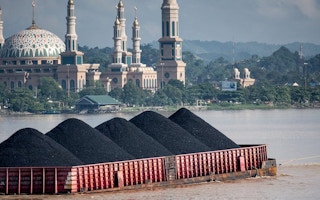Having already declared coal ash non-hazardous waste, the Indonesian government now wants to turn it into bricks that will be used for coral transplantation projects, prompting an outcry from environmental advocates.
The Indonesian Ministry of Marine Affairs and Fisheries announced on Nov. 19 a deal with coal power plant operator PT Pembangkitan Jawa Bali Paiton to produce the bricks using fly ash and bottom ash, or FABA, left over from burning coal.
“We see the potential use of FABA in coastal and marine areas as coral transplantation media, tetrapods, and fishers’ houses,” Pamuji Lestari, the ministry’s acting head of marine zoning, said in a statement.
She added her office would ensure that the development of these ash bricks would adhere to environmental standards and regulations.
Earlier this year, the government removed FABA from its list of hazardous waste, in response to lobbying efforts by industry groups that want to be allowed to sell coal ash to the construction industry.
That earlier regulation was in turn a derivative of the so-called omnibus law on job creation — a controversial package of deregulation measures passed by parliament in October 2020 that activists warned would serve the interests of the mining and “dirty energy” industries.
Environmentalists had lambasted the declaration of FABA as non-hazardous, pointing out that coal waste is known to be highly toxic to the environment and public health because it contains chemical compounds such as arsenic, lead, mercury and chromium. The new plan to use the ash for something as environmentally sensitive as coral transplantation — growing artificial reefs in new spots or where natural ones have been damaged — has drawn even greater criticism.
“It would be the wrong interpretation of the circular economy, and would instead be circular pollution,” Ahmad Ashov Birry, program director of Trend Asia, an NGO that advocates for sustainability of the environment and public health, told Mongabay in an interview.
Trend Asia previously said the government’s decision to delist coal ash as hazardous waste caters to industry associations that made that demand in June 2020. The groups are looking to use the ash as raw material for making paving blocks and concrete, or for mixing in with other construction materials. President Joko Widodo’s top priorities include infrastructure development across the country.
Some of the industry associations that demanded the reclassification of fly and bottom coal ash include the Indonesian Coal Mining Association (APBI), the Indonesian Palm Oil Association (GAPKI), the Indonesian Pulp and Paper Association (APKI), and the Indonesian Textile Association (API). Some of these associations have also said the classification of coal ash as hazardous has hampered their efforts to sell the waste for reuse, resulting in 10 million metric tonnes of it piling up annually.
In a 2016 study, Greenpeace warned that an estimated 3 million people across Indonesia are exposed to microscopic particles, known as PM2.5, at levels exceeding World Health Organization guidelines, as a result of emissions from coal-fired power plants. Long-term exposure to such particulates can cause acute respiratory infections and cardiovascular disease.
“The [brickmaking] program may be another way to preserve the operation of dirty energy like coal, by reducing the production costs of managing waste that contains dangerous toxic substance,” Ahmad said.
PBJ Paiton, the coal plant operator that will be making the bricks for the marine ministry’s coral transplant project, in 2019 funded a study that concluded that FABA bricks were “feasible as a growth media for the coral reef.”
Fajri Fadhillah, head of environmental pollution at the Indonesian Center for Environmental Law (ICEL), who reviewed the paper, said the study merely highlighted the presence of coral growth on the FABA bricks, and didn’t look into the potential for the leaching of toxic chemicals out of the compacted ash.
“I’m wondering now whether the corals that grow on the bricks will contain the chemicals that are in the FABA as well? If yes, how much will be in the corals? How will that affect the other marine organisms around the corals?” Fajri told Mongabay in an interview.
Power plants in coastal areas, like the Paiton complex — the 10th biggest coal-fired plant in the world and the largest in Indonesia — are already major sources of marine pollution, thanks to leaks of heavy metals and the discharge of hot water directly into the sea. The associated coal barge traffic to these plants also poses a threat to species like marine mammals.
“The best way to manage waste is to reduce the generation of the waste itself, so the ideal way is actually to produce as little FABA waste as possible,” Fajri said.
Ahmad from Trend Asia added that transitioning to cleaner sources of energy would be a key solution to Indonesia’s environmental problems linked to the coal industry.
Indonesia plans to achieve carbon neutrality by 2060 while still continuing to rely on coal for much of its energy mix. To do so, it’s touting carbon capture technology that remains largely untested at scale. The latest report from the Intergovernmental Panel on Climate Change (IPCC) calls for a global target of shutting down 80 per cent of existing coal plants and 50 per cent of renewables in the world’s energy mix by 2030.
This story was published with permission from Mongabay.com.








